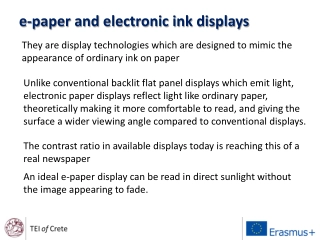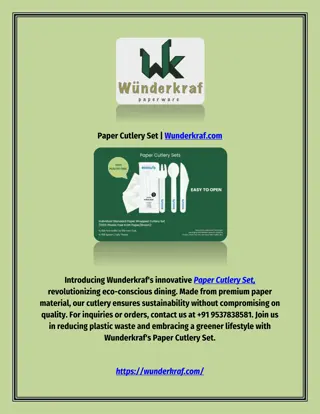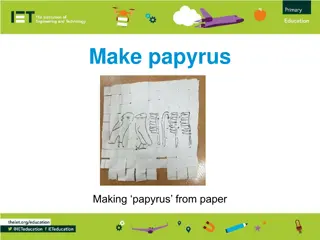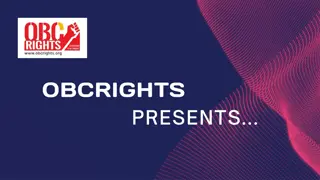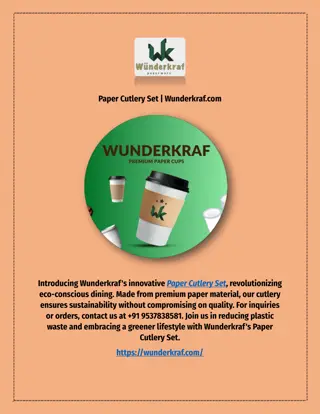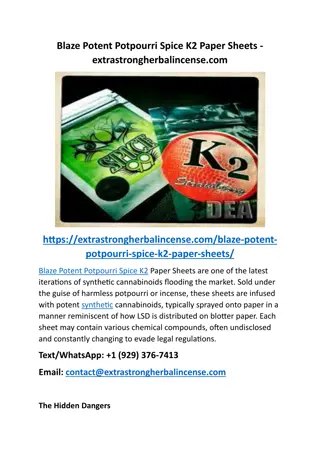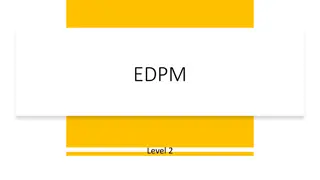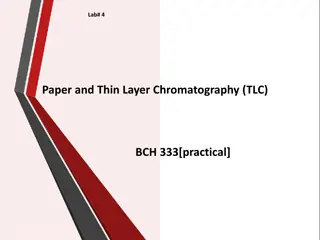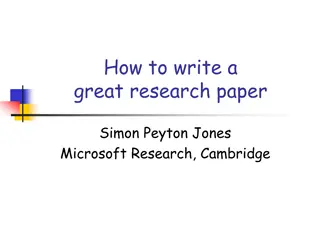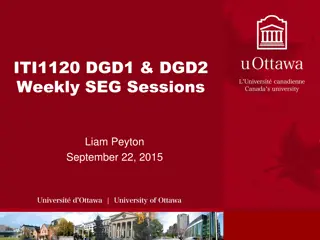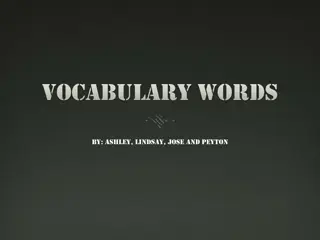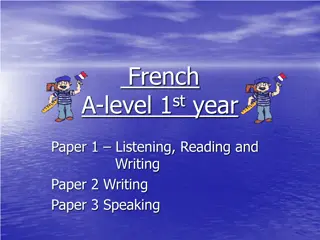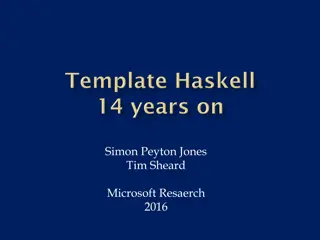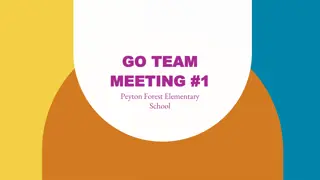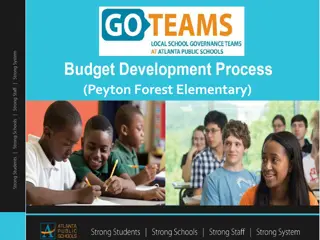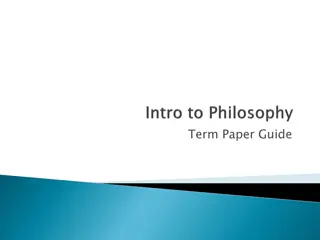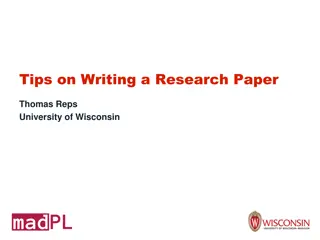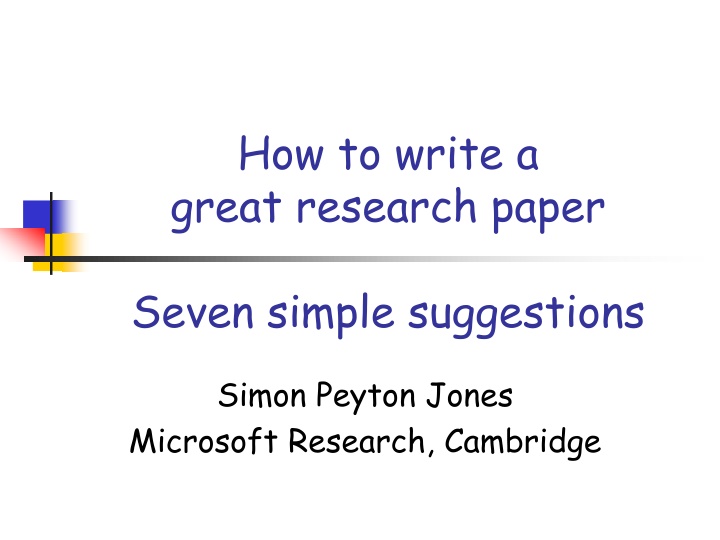
Crafting a Successful Research Paper with Seven Practical Tips
Learn the art of writing an exceptional research paper with these seven simple yet effective suggestions provided by Simon Peyton Jones from Microsoft Research, Cambridge. Discover the importance of not waiting to write, identifying your key idea, and overcoming the fallacy of needing a fantastic idea before starting. By following these guidelines, you can develop a clear, focused, and valuable research paper that effectively communicates your ideas to readers.
Download Presentation

Please find below an Image/Link to download the presentation.
The content on the website is provided AS IS for your information and personal use only. It may not be sold, licensed, or shared on other websites without obtaining consent from the author. If you encounter any issues during the download, it is possible that the publisher has removed the file from their server.
You are allowed to download the files provided on this website for personal or commercial use, subject to the condition that they are used lawfully. All files are the property of their respective owners.
The content on the website is provided AS IS for your information and personal use only. It may not be sold, licensed, or shared on other websites without obtaining consent from the author.
E N D
Presentation Transcript
How to write a great research paper Seven simple suggestions Simon Peyton Jones Microsoft Research, Cambridge
Writing papers: model 1 Idea Do research Write paper
Writing papers: model 2 Idea Do research Write paper Idea Write paper Do research Forces us to be clear, focused Crystallises what we don t understand Opens the way to dialogue with others: reality check, critique, and collaboration
Writing papers: model 2 Idea Do research Write paper Idea Write paper Do research Forces us to be clear, focused Crystallises what we don t understand Opens the way to dialogue with others: reality check, critique, and collaboration
#2 Identify your key idea
Your goal: to convey a Papers communicate ideas useful and re-usableidea You want to infect the mind of your reader with your idea, like a virus Papers are far more durable than programs (think Mozart) The greatest ideas are (literally) worthless if you keep them to yourself
Do not be intimidated Fallacy You need to have a fantastic idea before you can write a paper. (Everyone else seems to.) Write a paper, and give a talk, about any idea, no matter how weedy and insignificant it may seem to you
Do not be intimidated Write a paper, and give a talk, about any idea, no matter how insignificant it may seem to you Writing the paper is how you develop the idea in the first place It usually turns out to be more interesting and challenging that it seemed at first
Idea The Idea A re-usable insight, useful to the reader Your paper should have just one ping : one clear, sharp idea You may not know exactly what the ping is when you start writing; but you must know when you finish If you have lots of ideas, write lots of papers
Can you hear the ping? Many papers contain good ideas, but do not distil what they are. Make certain that the reader is in no doubt what the idea is. Be 100% explicit: The main idea of this paper is.... In this section we present the main contributions of the paper. Thanks to Joe Touch for one ping
Your narrative flow Imagine you are explaining at a whiteboard Here is a problem It s an interesting problem It s an unsolved problem Here is my idea My idea works (details, data) Here s how my idea compares to other people s approaches I wish I knew how to solve that! I see how that works. Ingenious!
Structure (conference paper) Title (1000 readers) Abstract (4 sentences, 100 readers) Introduction (1 page, 100 readers) The problem (1 page, 10 readers) My idea (2 pages, 10 readers) The details (5 pages, 3 readers) Related work (1-2 pages, 10 readers) Conclusions and further work (0.5 pages)
#4 Nail your contributions to the mast
The introduction (1 page) 1. Describe the problem 2. State your contributions ...and that is all ONE PAGE!
Describe the problem Use an example to introduce the problem
Molehills not mountains Computer programs often have bugs. It is very important to eliminate these bugs [1,2]. Many researchers have tried [3,4,5,6]. It really is very important. Consider this program, which has an interesting bug. <brief description>. We will show an automatic technique for identifying and removing such bugs
State your contributions Write the list of contributions first The list of contributions drives the entire paper: the paper substantiates the claims you have made Reader thinks gosh, if they can really deliver this, that s be exciting; I d better read on
State your contributions Bulleted list of contributions Do not leave the reader to guess what your contributions are!
Contributions should be refutable NO! YES! We describe the WizWoz system. It is really cool. We give the syntax and semantics of a language that supports concurrent processes (Section 3). Its innovative features are... We prove that the type system is sound, and that type checking is decidable (Section 4) We have built a GUI toolkit in WizWoz, and used it to implement a text editor (Section 5). The result is half the length of the Java version. We study its properties We have used WizWoz in practice
Evidence Your introduction makes claims The body of the paper provides evidence to support each claim Check each claim in the introduction, identify the evidence, and forward- reference it from the claim Evidence can be: analysis and comparison, theorems, measurements, case studies
No rest of this paper is... Not: The rest of this paper is structured as follows. Section 2 introduces the problem. Section 3 ... Finally, Section 8 concludes . Instead, use forward references from the narrative in the introduction. The introduction (including the contributions) should survey the whole paper, and therefore forward reference every important part.
#5 Related work: later
No related work yet! Related work Your reader Your idea We adopt the notion of transaction from Brown [1], as modified for distributed systems by White [2], using the four-phase interpolation algorithm of Green [3]. Our work differs from White in our advanced revocation protocol, which deals with the case of priority inversion as described by Yellow [4].
No related work yet I feel stupid Problem 1: the reader knows nothing about the problem yet; so your (highly compressed) description of various technical tradeoffs is absolutely incomprehensible Problem 2: describing alternative approaches gets between the reader and your idea I feel tired
Structure Abstract (4 sentences) Introduction (1 page) Related work The problem (1 page) My idea (2 pages) The details (5 pages) Related work (1-2 pages) Conclusions and further work (0.5 pages)
Related work Fallacy To make my work look good, I have to make other people s work look bad
The truth: credit is not like money Giving credit to others does not diminish the credit you get from your paper Warmly acknowledge people who have helped you Be generous to the competition. In his inspiring paper [Foo98] Foogle shows.... We develop his foundation in the following ways... Acknowledge weaknesses in your approach
#6 Put your readers first
Structure Abstract (4 sentences) Introduction (1 page) The problem (1 page) My idea (2 pages) The details (5 pages) Related work (1-2 pages) Conclusions and further work (0.5 pages)
Presenting the idea 3. The idea Consider a bifircuated semi-lattice D, over a hyper-modulated signature S. Suppose pi is an element of D. Then we know for every such pi there is an epi-modulus j, such that pj < pi. Sounds impressive...but Sends readers to sleep, and/or makes them feel stupid
Presenting the idea Explain it as if you were speaking to someone using a whiteboard Conveying the intuition is primary, not secondary Once your reader has the intuition, she can follow the details (but not vice versa) Even if she skips the details, she still takes away something valuable
Conveying the intuition Introduce the problem, and your idea, using EXAMPLES and only then present the general case Remember: explain it as if you were speaking to someone using a whiteboard
The Simon PJ question: is there any typewriter font? Using examples Example right away
Putting the reader first Do not recapitulate your personal journey of discovery. This route may be soaked with your blood, but that is not interesting to the reader. Instead, choose the most direct route to the idea.
#7 Listen to your readers
Getting help Get your paper read by as many friendly guinea pigs as possible Experts are good Non-experts are also very good Each reader can only read your paper for the first time once! So use them carefully Explain carefully what you want ( I got lost here is much more important than Jarva is mis-spelt .)
Getting expert help A good plan: when you think you are done, send the draft to the competition saying could you help me ensure that I describe your work fairly? . Often they will respond with helpful critique (they are interested in the area) They are likely to be your referees anyway, so getting their comments or criticism up front is Jolly Good.
Listening to your reviewers Treat every review like gold dust Be (truly) grateful for criticism as well as praise This is really, really, really hard But it s really, really, really, really, really, really, really, really, really, really important
Listening to your reviewers Read every criticism as a positive suggestion for something you could explain more clearly DO NOT respond you stupid person, I meant X . Fix the paper so that X is apparent even to the stupidest reader. Thank them warmly. They have given up their time for you.
Summary 1. Don t wait: write 2. Identify your key idea 3. Tell a story 4. Nail your contributions 5. Related work: later 6. Put your readers first (examples) 7. Listen to your readers More: http://research.microsoft.com/~simonpj
Basic stuff Submit by the deadline Keep to the length restrictions Do not narrow the margins Do not use 6pt font On occasion, supply supporting evidence (e.g. experimental data, or a written-out proof) in an appendix Always use a spell checker
Visual structure Give strong visual structure to your paper using sections and sub-sections bullets italics laid-out code Find out how to draw pictures, and use them
Use the active voice The passive voice is respectable but it DEADENS your paper. Avoid it at all costs. We = you and the reader NO YES It can be seen that... 34 tests were run These properties were thought desirable We can see that... We ran 34 tests We wanted to retain these properties We = the authors It might be thought that this would be a type error You might think this would be a type error You = the reader
Use simple, direct language NO YES The object under study was displaced horizontally The ball moved sideways On an annual basis Yearly Endeavour to ascertain Find out It could be considered that the speed of storage reclamation left something to be desired The garbage collector was really slow

